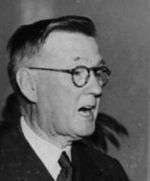Queensland state election, 1944
| | ||||||||||||||||||||||||||||||||||||||||||||
| ||||||||||||||||||||||||||||||||||||||||||||
| ||||||||||||||||||||||||||||||||||||||||||||
| ||||||||||||||||||||||||||||||||||||||||||||
Elections were held in the Australian state of Queensland on 15 April 1944 to elect the 62 members of the state's Legislative Assembly.
The election was the first that Labor had contested under Premier Frank Cooper, who had been in office for 19 months by the time of the poll.
From this election, the voting method was changed from contingency voting to First past the post voting. Queensland retained this method for state elections until Preferential Voting was restored by the Country/Liberal Coalition at the 1963 state election.
The election resulted in Labor receiving a fifth term in office, albeit with a reduced majority.
Key dates
| Date | Event |
|---|---|
| 23 February 1944 | The Parliament was dissolved.[1] |
| 24 February 1944 | Writs were issued by the Governor to proceed with an election.[2] |
| 3 March 1944 | Close of nominations. |
| 15 April 1944 | Polling day, between the hours of 8am and 6pm. |
| 27 April 1944 | The Cooper Ministry was reconstituted.[3] |
| 29 May 1944 | The writ was returned and the results formally declared. |
| 1 August 1944 | Parliament resumed for business.[4] |
Parties and independents
Some ructions had developed between some sections of the Labor Party and the party's AWU-dominated executive, resulting in tiny splinter movements which were, however, locally effective. The Hermit Park branch in Townsville, which had dominated the Townsville City Council since 1939, was expelled from the ALP for alleged disloyalty in 1942,[5] possibly due to association with Communists. Tom Aikens won the seat of Mundingburra at the election. Similar forces saw sitting left-wing members George Taylor (Enoggera) and George Marriott (Bulimba) expelled from the party; the former lost his seat to a QPP candidate, while the latter retained his at the 1944 and 1947 elections. Frank Barnes, a colourful identity who supported social credit theories popular since the Great Depression and declared himself opposed to the Labor government, retained his seat of Bundaberg.
Various changes were taking place in conservative politics as well, with the dissolution of the United Australia Party and the formation of the Queensland People's Party (QPP), led by the mayor of Brisbane and member for Hamilton, Sir John Beals Chandler. The two independent conservatives elected in 1941 were both out of parliament by the election — Arthur Bruce Pie had resigned to contest the 1943 federal election, whilst William Deacon had died. One of the former United Australia Party members, Louis Luckins (Maree), did not join the QPP originally and retained his seat in 1944 as an independent.
Apart from the above, numerous independent candidates contested with a range of banners, including Democrat, Christian Socialist, Servicemen's Association, People's Party and Independent Country Party, none of them achieving more than a few hundred votes.
Fred Paterson was elected in Bowen, the only member of the Communist Party of Australia to be elected to an Australian parliament.
Results
The election saw a swing away from Labor based on the 1941 election, as indicated in the table below. In net terms, Labor lost four seats, although it still had a healthy working majority.
|
Queensland state election, 15 April 1944[6] | ||||||
|---|---|---|---|---|---|---|
| Enrolled voters | 585,727[1] | |||||
| Votes cast | 512,767 | Turnout | 87.54 | –2.75 | ||
| Informal votes | 9,352 | Informal | 1.82 | +0.02 | ||
| Summary of votes by party | ||||||
| Party | Primary votes | % | Swing | Seats | Change | |
| Labor | 224,888 | 44.67 | –6.74 | 37 | – 4 | |
| Queensland People's Party | 124,437 | 24.72 | +9.11 | 7 | + 3 | |
| Country | 88,608 | 17.60 | –3.29 | 12 | – 2 | |
| Communist | 12,467 | 2.48 | –0.61 | 1 | + 1 | |
| Ind. Labor | 12,154 | 2.41 | +0.67 | 1 | + 1 | |
| Frank Barnes Labor[2] | 9,970 | 1.98 | +0.93 | 2 | + 1 | |
| Hermit Park Labor | 5,521 | 1.10 | +1.10 | 1 | + 1 | |
| Ind. Country | 1,654 | 0.33 | –0.45 | 0 | ± 0 | |
| Independent | 23,716 | 4.71 | +1.29 | 1 | – 1 | |
| Total | 503,415 | 62 | ||||
- 1 655,984 electors were enrolled to vote at the election, but 7 seats (11.3% of the total) were uncontested—6 Labor seats (2 more than in 1941) representing 58,561 enrolled voters and one Country seat representing 11,696 enrolled voters.
- 2 At the election, Frank Barnes and his brother Lou Barnes, both incumbents but the latter having gained the seat at a 1942 by-election, retained their seats. They contested later elections under the banner "Frank Barnes Labor".
See also
- Members of the Queensland Legislative Assembly, 1941–1944
- Members of the Queensland Legislative Assembly, 1944–1947
- Candidates of the Queensland state election, 1944
- Cooper Ministry
References
- ↑ "A Proclamation". Queensland Government Gazette. 23 February 1944. p. 162:489.
- ↑ Queensland Government Gazette. 24 February 1944. p. 162:493. Missing or empty
|title=(help) - ↑ Queensland Government Gazette. 27 April 1944. p. 162:830. Missing or empty
|title=(help) - ↑ Queensland Government Gazette. 6 July 1944. p. 163:33. Missing or empty
|title=(help) - ↑ "JCU Library Archives - A.D. Murgatroyd Collection". Retrieved 20 December 2009.
- ↑ Australian Government and Politics Database. "Parliament of Queensland, Assembly election, 15 April 1944". Retrieved 20 December 2009.
| ||||||||||

